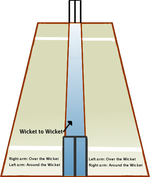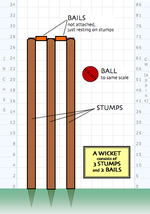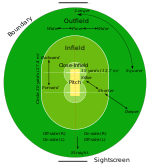The playing field
- For more details on this topic, see Cricket field.
The cricket field consists of a large circular or oval-shaped grassy ground. There are no fixed dimensions for the field but its diameter usually varies between 450 feet (137 m) and 500 feet (150 m). On most grounds, a rope marks the perimeter of the field and is known as the boundary.
The pitch
- For more details on this topic, see Cricket pitch.


Most of the action takes place in the centre of this ground, on a rectangular clay strip usually with short grass called the pitch. The pitch measures 10 × 66 feet (3.05 × 20.12 m).
At each end of the pitch three upright wooden stakes, called the stumps, are hammered into the ground. Two wooden crosspieces, known as the bails, sit in grooves atop the stumps, linking each to its neighbour. Each set of three stumps and two bails is collectively known as a wicket. One end of the pitch is designated the batting end where the batsman stands and the other is designated the bowling end where the bowler runs in to bowl. The area of the field on the side of the line joining the wickets where the batsman holds his bat (the right-hand side for a right-handed batsman, the left for a left-hander) is known as the off side, the other as the leg side or on side.
Lines drawn or painted on the pitch are known as creases. Creases are used to adjudicate the dismissals of batsmen and to determine whether a delivery is legal.
The nature of the pitch
Pitches vary in consistency, and thus in the amount of bounce, spin, and seam movement available to the bowler. Hard pitches are usually good to bat on because of high but even bounce. Dry pitches tend to deteriorate for batting as cracks often appear, and when this happens spinners can play a major role. Damp pitches, or pitches covered in grass (termed "green" pitches), allow good fast bowlers to extract extra bounce and seam movement. Such pitches tend to offer help to fast bowlers throughout the match, but become better for batting as the game goes on.
Parts of the field
For a one-innings match played over a set number of fair deliveries, there are two additional field markings. A painted oval is made by drawing a semicircle of 30 yards (27.4 m) radius from the centre of each wicket with respect to the breadth of the pitch and joining them with lines parallel, 30 yards (27.4 m) to the length of the pitch. This line, commonly known as the circle, divides the field into an infield and outfield. Two circles of radius 15 yards (13.7 m), centred on each wicket and often marked by dots, define the close-infield. The infield, outfield, and the close-infield are used to enforce fielding restrictions.


No comments:
Post a Comment